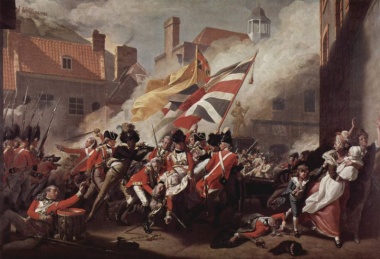Conflict:
The Battle of Jersey was fought during the Wars of the American Revolution.
Date:
Baron Phillipe de Rullecourt and his forces landed on January 5, 1781. They were defeated at the Battle of Jersey the following day.
Armies & Commanders:
British
Major Francis Peirson
Governor Moses Corbet
2,000+ men
French
Baron Phillipe de Rullecourt
Prince Emire
approx. 1,000 men
Battle Summary:
|
|
During the Wars of the American Revolution, the Channel Island of Jersey served as a frontline base for British privateers preying on French shipping. Located only fourteen miles from the French coast, Jersey was perfectly positioned for these raiders to strike at enemy shipping. Aware of the island's value, the British constructed a series of fortresses and redoubts around the island's coast. In addition elements of the 78th, 83rd, and 95th Regiments of Foot had been ordered to island to supplement its 3,000-man militia, for a total garrison of around 9,250.
Despite the strength of its defenses, the French government moved forward with plans to capture the island. It was hoped that in addition to securing Jersey, the invasion would draw off British forces from attempting to relieve the siege of Gibraltar. As the French military felt an attack against the island would be waste, with only short-lived gains, organization for the invasion was made a private affair under the guidance of Baron Philippe de Rullecourt. A colonel in the French army, de Rullecourt was fully funded and backed by King Louis XVI, and he quickly set about assembling a picked force of 2,000 men.
Dividing his force into four divisions, de Rullecourt embarked his men on January 5, 1781. The first division of 800 men landed at Grouville on the 6th and, taking advantage of the island's "Old Christmas Night" celebrations, were able to evade the British guards. They were reinforced the next morning by the 200 men of the fourth division, as the second and third divisions had been lost on the rocks landing and become lost respectively. With his force reduced by half, de Rullecourt advanced on the island's capital of St. Helier. Arriving shortly after dawn, his men went into camp in the town's market square.
At 8:00 AM, French troops seized the island's governor, Moses Corbet, from his bed at Government House. Rullecourt convinced Corbet that thousands of French troops had landed and demanded that he surrender and order the island's garrisons to do the same. Lacking true information, Corbet complied. As the morning progressed it became clear to British that the French force did not exceed 800-1,000 men. With this knowledge, British positions around Jersey promptly refused to follow Corbet's surrender instructions. At Westmount, Major Francis Peirson began assembling a force to attack the French.
Unable to compel St. Helier's fortress, Elizabeth Castle, to surrender, and lacking the men to fully occupy the island, de Rullecourt ordered that the market square be fortified to resist the anticipated British counterattack. With over 2,000 men gathered, Peirson advanced on St. Helier. Moving into the town's streets, the size of his force became a hindrance with many men unable to take part in the fight. With the 78th Regiment, the Battalion of St. Lawrence, the South-East Regiment, and the Compagnies de Saint-Jean moving up the Grand Rue and the 95th Regiment and militia on adjacent streets, the battle started.
Charging through St. Helier's streets, and supported by howitzer fire, the British swiftly overwhelmed the French. In the fighting, which lasted approximately 15-20 minutes, Peirson was struck down when he was hit in the chest with a musket ball. On the French side, de Rullecourt was also mortally wounded. Upon seeing their commander fall, the French resistance crumbled. With the alarm raised, the bulk of the island's defenders were able to swiftly round up the remaining elements of de Rullecourt's invasion force.
Aftermath:
The Battle of Jersey cost the British defenders approximately 30 dead and wounded, among them Major Francis Peirson. French casualties were about the same and included Baron de Rullecourt. Over 600 French prisoners were taken later that day, all of which were shipped back to England. After assessing the invasion attempt, the British concluded that the island's defenses were inadequate and began the construction of thirty round towers along the coasts. The 1781 invasion marked the last time the French attempted to wrest control of the Channel Islands from the British.



